
Recipe: Classic has a twist; non-dairy version is also vegan
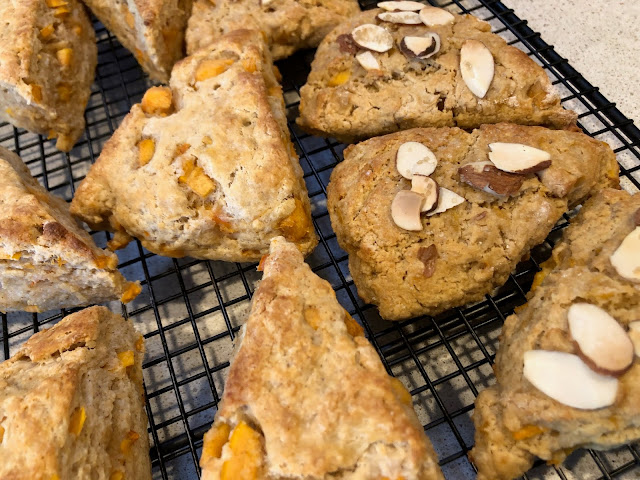 |
| Persimmon chunks add sweetness to two scone variations. (Photos: Kathy Morrison) |
Breakfast baking is my favorite way to use fruit in season. November brings gorgeous orange persimmons to market, so I wanted to give the crisp variety, the squat Fuyus, a try in a scone recipe. (The heart-shaped Hachiya persimmons must be mushy-ripe to use in baking.)
So I went looking for recipes that were well-spiced, at least somewhat healthy (for a scone) and featured the fruit nicely. I found two versions that were close enough to each other that I suspect they were adapted from the same original recipe. The major difference: One version is vegan/non-dairy and made with whole-wheat and almond flour. But the more-classic recipe, using butter, also has a twist: A generous portion of ricotta cheese. (That one came from the Electrolux website; I had no idea they offered recipes!)
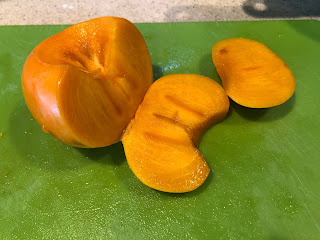
|
When choosing persimmons for this recipe, go for ones that still have some firmness rather than being soft-ripe. They'll be easier to chop and mix. Also watch out for the occasional seed in the middle when coring them -- of 4 persimmons I used, 2 had seeds.
Both recipes bake up nicely; I tried them side by side so they'd have the same baking sheet and oven temperature. The thicker classic version actually baked faster and made an excellent breakfast bread; it would take well to being split and spread with butter or jam.
The vegan scone had a texture closer to muffins than flaky scones -- I'd recommend not splitting it -- and was also very good. Cardamom is the only spice in this one, but it could take additional spices if you like.
Both are just lightly sweet; if you like sweeter scones, add a glaze or sweet topping of your choice.
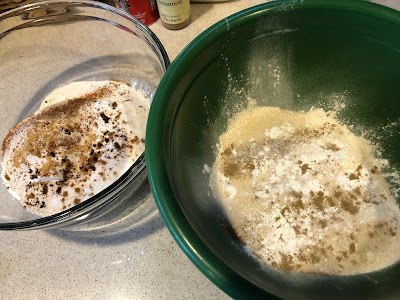
|
|
.
|
Whole-wheat persimmon ricotta scones
Adapted slightly from electroluxappliances.com
Makes 8
Ingredients:
1 cup unbleached all-purpose flour
1 cup whole-wheat flour
1 tablespoon baking powder
1/4 cup granulated cane sugar
1/2 teaspoon sea salt
1/4 teaspoon cinnamon
1/4 teaspoon ground ginger
1/4 teaspoon ground nutmeg
1/4 teaspoon ground cloves
1/8 teaspoon ground cardamom
6 tablespoons unsalted butter, well-chilled
1 cup cored and chopped Fuyu persimmons (2 of average size)
3/4 cup low fat or whole milk ricotta cheese
1/3 cup half-and-half, plus extra for brushing on top of scones
1 teaspoon vanilla extract
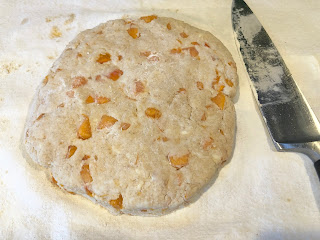
|
Instructions :
Preheat oven to 400 degrees. Line a baking sheet with parchment paper.
Mix the flours, baking powder, sugar, salt and spices together in a large bowl. Cut the butter into 1/4-inch pieces and add the chunks to the flour mixture, using a pastry blender or two knives to break up the pieces until they are the size of small peas. Stir in the persimmons until well-distributed.
Stir in the ricotta, half-and-half and vanilla, forming a rough dough. Turn the dough, including any dry bits from the bottom of the bowl, onto a flour-covered surface, and knead the dough gently with your hands about 3 or 4 times, until it holds together. Push the dough into a ball, then flatten it into a disk about 1-inch thick.
Use a knife or dough scraper to cut the disk into 8 wedges. Transfer the wedges to the prepared pan and brush them lightly with more half-and-half.
Bake the scones 17-20 minutes until lightly golden. Cool on rack.
Vegan persimmon almond scones
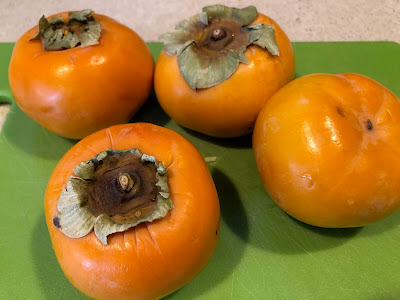 |
| Firmer Fuyu persimmons make the chopping easier. |
Adapted slightly from scalingbackblog.com
Makes 8
Ingredients:
1-1/2 cups whole-wheat pastry flour
1/2 cup almond flour
1/4 natural granulated cane sugar
1/2 teaspoon ground cardamom
1 tablespoon baking powder
1/2 teaspoon salt
3 tablespoons coconut oil, cold (this time of year it's usually solid, but chill briefly if not)
3/4 cup coconut milk (I used the beverage, not the canned variety), plus a bit more for brushing
1/2 teaspoon almond extract
1 cup cored and chopped Fuyu persimmons (2 of average size)
Sliced almonds for topping, optional
Turbinado sugar, for topping, optional
Instructions:
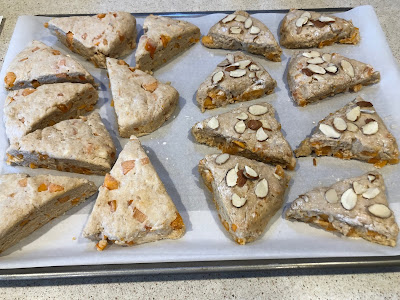 |
| Both varieties of scone, ready to be baked together. |
Preheat oven to 400 degrees. Line a baking sheet with parchment paper.
Mix the flours, sugar, cardamom, baking powder and salt together in a large bowl. Cut in the solid coconut oil, using a pastry blender or two knives to break up the pieces until the mixture resembles coarse crumbs.
Stir in the persimmons until well-distributed, and add the coconut milk and almond extract. This makes a wetter dough than the classic version above and won't require much blending.
Turn the dough gently onto a pastry-flour-covered surface, and pat it into a disk about 1 inch thick.
Use a knife or dough scraper to cut the disk into 8 wedges. Carefully transfer the wedges to the prepared pan and brush them lightly with more coconut milk. Sprinkle on the sliced almonds and turbinado sugar, if using
Bake the scones 22-25 minutes until golden. Cool on rack.
Comments
0 comments have been posted.Sacramento Digs Gardening to your inbox.
Food in My Back Yard Series
May 6: Maintain soil moisture with mulch for garden success
April 29: What's (already) wrong with my tomato plants?
April 22: Should you stock up on fertilizer? (Yes!)
April 15: Grow culinary herbs in containers
April 8: When to plant summer vegetables
April 1: Don't be fooled by these garden myths
March 25: Fertilizer tips: How to 'feed' your vegetables for healthy growth
March 18: Time to give vegetable seedlings some more space
March 11: Ways to win the fight against weeds
March 4: Potatoes from the garden
Feb. 25: Plant a fruit tree now -- for later
Feb. 18: How to squeeze more food into less space
Feb. 11: When to plant? Consider staggering your transplants
Feb. 4: Starting in seed starting
Sites We Like
Garden Checklist for week of May 11
Make the most of the lower temperatures early in the week. We’ll be back in the 80s by Thursday.
* Plant, plant, plant! It’s prime planting season in the Sacramento area. Time to set out those tomato transplants along with peppers and eggplants. Pinch off any flowers on new transplants to make them concentrate on establishing roots instead of setting premature fruit.
* Direct-seed melons, cucumbers, summer squash, corn, radishes, pumpkins and annual herbs such as basil.
* Harvest cabbage, lettuce, peas and green onions.
* In the flower garden, direct-seed sunflowers, cosmos, salvia, zinnias, marigolds, celosia and asters. (You also can transplant seedlings for many of the same flowers.)
* Plant dahlia tubers.
* Transplant petunias, marigolds and perennial flowers such as astilbe, columbine, coneflowers, coreopsis, dahlias, rudbeckia and verbena.
* Keep an eye out for slugs, snails, earwigs and aphids that want to dine on tender new growth.
* Feed summer bloomers with a balanced fertilizer.
* For continued bloom, cut off spent flowers on roses as well as other flowering plants.
* Add mulch to the garden to maintain moisture. Mulch also cuts down on weeds. But don’t let it mound around the stems or trunks of trees or shrubs. Leave about a 6-inch-to-1-foot circle to avoid crown rot or other problems.
* Remember to weed! Pull those nasties before they set seed.
* Water early in the day and keep seedlings evenly moist.